
The Peneda-Gerês National Park, also known simply as Gerês, is a national park located in northern Portugal. Created on 8 May 1971, it is the oldest protected area and the only national park in Portugal due to its national and international scientific interest. The park covers an area of 695.93 km2 (268.70 sq mi), occupying the Districts of Viana do Castelo, Braga, and Vila Real and bordering the Spanish Baixa Limia – Serra do Xurés natural park to the north, with which forms the UNESCO biosphere reserve of Gerês-Xurés.

Serra da Canastra National Park is a national park in the Canastra Mountains of the state of Minas Gerais, Brazil.
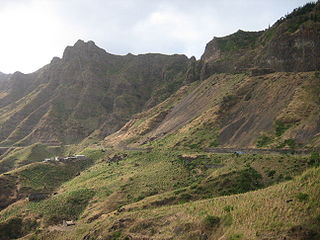
Serra Malagueta is a mountain range located in the northern part of the island of Santiago, Cape Verde. At 1064 m elevation, it is highest point of northern Santiago. The mountain range is protected as the Serra Malagueta Natural Park, that was established on February 24, 2005 and covers 774 hectares. The natural park is situated in the municipalities Tarrafal, São Miguel and Santa Catarina. The summit is in São Miguel, south of the Ribeira Principal valley. The Serra Malagueta formation is of volcanic origin, and was formed between 2.9 and 2.4 million years ago.

Aplastodiscus albosignatus, also known as the Bocaina treefrog, is a species of frog in the family Hylidae. It is endemic to Brazil. Its natural habitats are subtropical or tropical moist lowland forests, subtropical or tropical moist montane forests, and rivers. It is threatened by habitat loss.
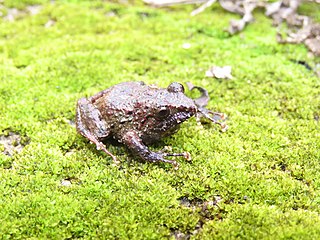
Ischnocnema holti is a species of frog in the family Brachycephalidae. It is endemic to the state of Rio de Janeiro, Brazil, and is known from the Serra da Mantiqueira in Itatiaia and Serra dos Órgãos in Teresópolis. Common name Holt's robber frog has been coined for this species.

Terminalia acuminata is a tree species in the Combretaceae family. It was endemic to the Atlantic Forest in Brazil. The species was believed to be extinct in the wild from habitat loss, entering the IUCN Red List in 1998, with two individuals remaining in the Rio de Janeiro Botanical Garden.
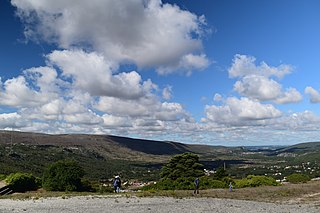
Serras de Aire e Candeeiros Natural Park (PNSAC) is a natural park in central west Portugal. It occupies an area of 383.9 km2 (148.2 sq mi) and is the most important repository of limestone formations in Portugal with a variety of geological formations associated with karst topography such as caves, sinkholes, uvalas, poljes, limestone pavements, ponors, among others. It was made a protected area in 1979 with the intend to protect the existing natural aspects and the architectonic and cultural heritage linked to the local populations.

Serra de Montejunto Protected Landscape is a protected landscape in the Montejunto-Estrela mountain range, spanning the municipalities of Alenquer and Cadaval in Lisbon District, Portugal. It is the highest natural viewpoint of Estremadura, rising to 666 metres (2,185 ft) of altitude. The area is part of the Estremenho Limestone Massif. Geologically is 15 kilometres (9.3 mi) long and 7 kilometres (4.3 mi) wide, and is rich in caves, sewage ponds and prehistoric fossils.

Serra Geral National Park is a national park in the states of Rio Grande do Sul and Santa Catarina, Brazil.

The Serra do Pardo National Park is a National park in the state of Pará, Brazil.

Serra da Cutia National Park is a national park in the state of Rondônia, Brazil.

Saint-Hilaire/Lange National Park is a national park in Paraná, Brazil.

Raso da Catarina Ecological Station is a strictly protected ecological station in the state of Bahia in Brazil. It lies in the Raso da Catarina ecoregion of the Caatinga biome.
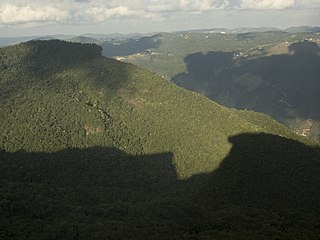
Serra da Mantiqueira Environmental Protection Area (Portuguese: Área de Proteção Ambiental da Serra da Mantiqueira is a protected area of Brazil that includes parts of the states of Minas Gerais, Rio de Janeiro and São Paulo.
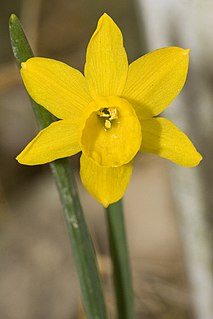
Narcissus calcicola is a species of narcissus (daffodils) in the family Amaryllidaceae. It is classified in Section Apodanthi. It is endemic to Portugal.
Arabis sadina is a species of flowering plant in the family Brassicaceae. It is endemic to Portugal.

The Nascentes da Serra do Cachimbo Biological Reserve is a biological reserve in the state of Pará, Brazil. The reserve protects an area in the transition between the Cerrado and Amazon biomes, supporting highly diverse flora and fauna including many endemic species. It is accessible via the BR-163 highway, and is among the federal conservation units in the Amazon Legal that has suffered most from deforestation.

The Serra das Confusões National Park is a national park in the state of Piauí, Brazil.

Xeroplexa setubalensis is a species of air-breathing land snail, a terrestrial pulmonate gastropod mollusk in the family Geomitridae. This species is endemic to Portugal. The taxa was previously placed within the genus Candidula until a molecular phylogenetic study revealed its current status. This taxon is the type species of the genus Xeroplexa.

Vaccinium cylindraceum, known by its common names such as Azores blueberry, is a semi-deciduous species of Vaccinium endemic to the Azores. It has gained the Royal Horticultural Society's Award of Garden Merit as an ornamental.

















